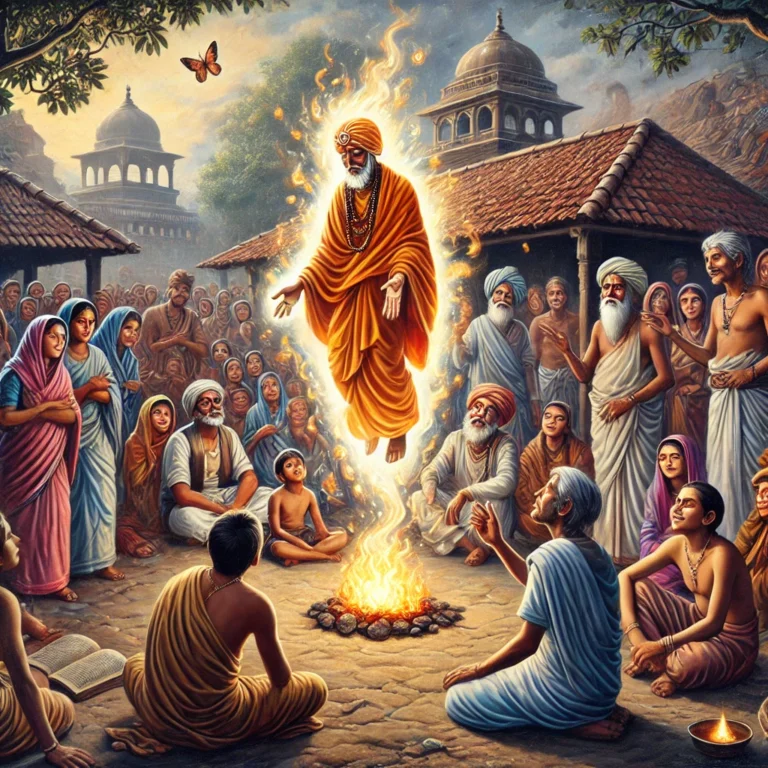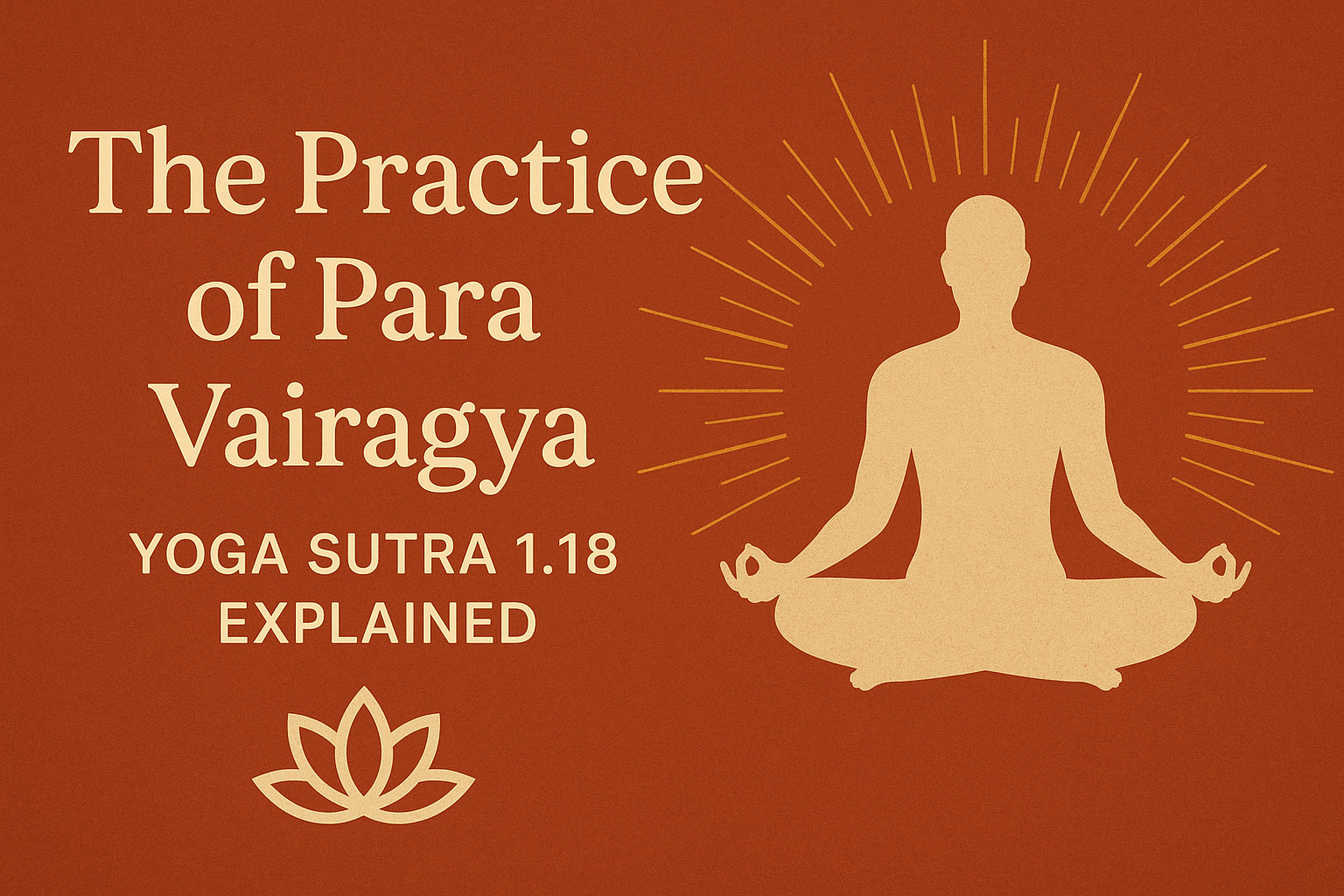Practice of Para Vairagya – Yoga Sutra 1.18 (Part 2)
Part 21: Patanjali Yoga Sutra Explained
Transition From Beyond Cognitive Samadhi To Practice of Para Vairagya
In the previous blog: Beyond Cognitive Samadhi: Understanding Asamprajnata Samadhi, we established that Asamprajnata Samadhi is fundamentally different from Samprajnata Samadhi – not merely a higher stage, but an entirely different category of consciousness. We explored why even Viveka-khyati (discriminative wisdom), though sublime, must be transcended because it remains a mental modification (vritti). Now we dive into the practical heart of Sutra 1.18: Practice Para of Vairagya through Practice.
Recalling Yoga Sutra 1.18: Practice of Para Vairagya
Before we explore how to practice Para Vairagya, let’s briefly recall the Sutra itself — the very foundation on which this discussion rests:
विरामप्रत्ययाभ्यासपूर्वः संस्कारशेषोऽन्यः ॥ १.१८ ॥
Virāma-pratyayābhyāsa-pūrvaḥ saṁskāra-śeṣo’nyaḥ
Translation:
“The other (Asamprajnata Samadhi), preceded by the repeated practice of cessation (Virāma-pratyaya), is that in which only the impressions of cessation remain.”
In the previous blog, Beyond Cognitive Samadhi: Understanding Asamprajnata Samadhi, we examined how this sutra describes a state of complete stillness — where even the most refined mental activity (Samprajnata Samadhi) ceases. Consciousness no longer engages with any object; only the subtle residue (samskara-śeṣa) of cessation persists.
Now, in blog, Practice of Para Vairagya – Yoga Sutra 1.18, we turn to the practical dimension:
✨ What does it mean to practice “Virāma-pratyaya”?
✨ How is Para Vairagya — supreme detachment — actually cultivated?
✨ How does this practice transform the mind to reach the threshold of Asamprajnata Samadhi?
This is where the philosophy of Yoga becomes living sādhanā — the art of transcending even the awareness of transcendence.
Virāma-Pratyaya: Understanding the Cause of Cessation
What is Para Vairagya in Practice?
Recall from Patanjali Yoga Sutra 1.16: Yoga Beyond Gunas Attachment and Yoga: The Gateway to Infinity – A Comprehensive Resource Guide, that Para Vairagya (supreme detachment) is freedom from craving even for the gunas themselves – detachment from even the experience of Purusha.
The commentary provides profound practical guidance:
“The practice of this Virāma-pratyaya, that is Para Vairagya, is to remove even this vritti through ‘Neti-Neti’ – ‘This is not the state of Atman, this is not establishment in one’s own nature.'”
This is where philosophy becomes practice.
The Neti-Neti Method: Your Primary Tool
नेति नेति (Neti Neti) – “Not this, not this”
This is one of the most powerful techniques in all of Vedantic and Yogic practice. Here’s how it applies specifically to reaching Asamprajnata Samadhi:
Stage 1: After Achieving Vitarka Samadhi
The experience:
- You can hold awareness of gross objects in deep absorption
- Reality of physical forms becomes luminously clear
- Sense of mastery over perception arises
This helps in separating perception from reality.
The practice:
- Recognition: “This clarity about physical reality is wonderful”
- Neti-Neti: “But this is not my essential nature. I am not this knowing.”
- Result: Detachment from gross object absorption grows
Stage 2: After Achieving Vichara Samadhi
The experience:
- You perceive subtle elements, tanmatras
- May glimpse celestial realms or cosmic patterns
- Sense of expanded consciousness emerges
The practice:
- Recognition: “I perceive the subtle fabric of existence”
- Neti-Neti: “But this is not ultimate reality. This is not my true Self.”
- Result: Detachment from subtle object absorption develops
Stage 3: After Achieving Ananda Samadhi
The experience:
- Profound bliss through awareness of Ahamkara (ego-principle)
- Peace beyond anything worldly
- Strong pull to remain in this state
The practice:
- Recognition: “This bliss is beyond anything mundane. Perhaps this is liberation?”
- Neti-Neti: “But this bliss is still of the mind. ‘I am blissful’ is still a state, not Being itself.”
- Result: Even blissful identification begins to release
Stage 4: After Achieving Asmita Samadhi
The experience:
- Resting in pure I-am-ness
- Experiencing limitless, unbounded existence
- Sense of infinite expansion
The practice:
- Recognition: “I am infinite, I am pure being, I am consciousness”
- Neti-Neti: “But even this ‘I am’ is still a vritti, still Chitta reflecting Purusha, not Purusha itself.”
- Result: The subtlest identification begins to dissolve
Stage 5: The Ultimate Application – Viveka-khyati
The experience:
- Discriminative wisdom arises
- Clear perception of difference between Purusha and Prakriti
- Sense of having “arrived” at the goal
The practice:
- Recognition: “I clearly see the distinction between pure consciousness and mind-matter. This is Viveka-khyati!”
- Neti-Neti: “But this very discrimination is still Chitta’s function. True Self doesn’t ‘know’ itself as an object. It simply IS.”
- Result: Even discriminative wisdom is released

The Subtlety of the Final Release
This final letting-go is extraordinarily subtle. The commentary emphasizes:
“When through repeated practice, even this one-pointed vritti (Viveka-khyati) is stopped, then Asamprajnata Samadhi occurs.”
The paradox:
- You use consciousness to become conscious of consciousness
- You use discrimination to see the discriminator
- You use the mind to transcend the mind
- You use knowledge to go beyond knowledge
The resolution:
- Eventually, the tool must be released
- The raft that carried you across must be left behind (This means one has to detach oneself from the very body that helps him to lead to the realization)
- The final vritti must cease
- Not through force, but through supreme detachment
The Mirror Analogy: A Deeper Understanding
The Patanjala Yoga Pradeep commentary uses a powerful analogy:
“Just as the form seen in a mirror is not the real form, similarly the perception of Atman in Chitta is not the real state of one’s own nature.”
In Samprajnata Samadhi (Even Viveka-khyati)
- Chitta becomes perfectly pure (like a flawless mirror)
- Purusha reflects in it perfectly
- The yogi perceives this reflection
- There’s awareness: “I am witnessing consciousness; I am not the mind”
But it’s still a reflection!
- Subject (witness) and object (witnessed) remain
- Chitta is still functioning
- The gunas are still operating (predominantly Sattva)
- It’s knowledge ABOUT the self, not self-established-in-self
In Asamprajnata Samadhi
- The mirror dissolves (metaphorically)
- No reflection remains
- Consciousness doesn’t perceive itself
- It simply IS itself
- Purusha established in its own nature (Svarupa-avasthiti)
This is the crucial difference that makes Asamprajnata “anyaḥ” – fundamentally other.
Punaḥ-Punaḥ Anuṣṭhāna: The Critical Importance of Repetition
The Key to Practice of Para Vairagya
The sutra emphasizes अभ्यासपूर्वः (abhyāsa-pūrvaḥ) – preceded by practice, specifically repeated practice (punaḥ-punaḥ anuṣṭhāna – again and again implementation).
Why Repetition is Essential
1. Building Nirodha Samskaras
- Each application of Neti-Neti creates cessation impressions
- These must become stronger than all other samskaras
- This requires countless repetitions
- Like strengthening a muscle through exercise
2. Weakening Ekaagrata Samskaras
- The habit of one-pointed concentration is powerful
- Even after achieving Samprajnata Samadhi, the mind wants to return to it
- It’s comfortable, familiar, blissful
- Repeated detachment weakens this gravitational pull
3. Stabilizing the Glimpses
- Initial experiences of Asamprajnata are momentary (we’ll explore this in Part 2B)
- Through repetition, they become longer
- Eventually, they stabilize
- Like learning to balance – falls become less frequent
4. Building Momentum
- Like a wheel that turns faster with each push
- Each practice session strengthens the capacity
- Eventually, a critical mass is reached
- The transition becomes natural
The Practice Rhythm
Daily Practice:
- Enter Samprajnata Samadhi (your current level)
- Once stable, apply Neti-Neti
- Experience momentary cessation
- Return to ordinary awareness
- Observe the effects
- Repeat the next day
Over Weeks and Months:
- The momentary cessation becomes slightly longer
- Re-entry after cessation becomes smoother
- The pull back to Vyutthana (ordinary mind) weakens
- Nirodha samskaras strengthen noticeably
Over Years:
- Asamprajnata becomes accessible more reliably
- Duration extends significantly
- The state feels increasingly natural
- Life transforms spontaneously
Eventually:
- Cessation is the default state
- Activity arises only when needed
- No sense of personal doership
- Only the impulse to help others brings return to activity

Read on Discipline & Practice →
The Progressive Destruction of Samskaras
One of the most fascinating aspects of this sutra is how it describes the progressive neutralization of mental impressions.
The Four Types of Samskaras
1. व्युत्थान संस्कार (Vyutthana samskaras)
- Nature: Impressions of ordinary scattered mental activity
- Result of: Tamas and Rajas predominance
- Keep us in: Normal waking consciousness with all its concerns
- Like: Static on a radio, preventing clear reception
2. समाधि-प्रारम्भ संस्कार (Samadhi-prarambha samskaras)
- Nature: Impressions from beginning concentration
- Result of: Increasing Sattva
- Lead to: Initial meditative states, moments of clarity
- Like: Static clearing occasionally, catching glimpses of the signal
3. एकाग्रता संस्कार (Ekaagrata samskaras)
- Nature: Impressions of one-pointedness
- Result of: Sattva predominance
- Create: Sustained deep meditation (all Samprajnata Samadhi)
- Like: Clear, stable signal – the program is fully audible
4. निरोध संस्कार (Nirodha samskaras)
- Nature: Impressions of complete cessation
- Created by: Para Vairagya practice
- Lead to: Asamprajnata Samadhi
- Like: Turning off the radio entirely – silence itself
The Cascade Effect
Each higher category neutralizes the lower:
Vyutthana samskaras
↓ (destroyed by)
Samadhi-prarambha samskaras
↓ (destroyed by)
Ekaagrata samskaras
↓ (destroyed by)
Nirodha samskaras
↓ (finally destroy themselves)
KAIVALYA
The commentary states clearly:
“The impressions arising from Vyutthana are destroyed by impressions arising from Samadhi-prarambha. Impressions from Samadhi-prarambha are destroyed by impressions from Ekaagrata. And impressions from Ekaagrata are destroyed by impressions from Nirodha.”

Learn Non-Attachment Practice →
Separating Pure From Impure
The Gold and Lead Metaphor
The commentary provides a beautiful illustration:
“Just as when gold is heated in fire, the lead added to it first burns away the gold’s impurities and then burns itself away, similarly when the impressions created by cessation destroy the impressions created by one-pointedness and then destroy themselves, the cessation of this samskara-shesha is called Kaivalya.”
Understanding the metaphor:
- The gold = Purusha (pure consciousness), always pure in essence
- The impurities = Vyutthana and ekaagrata samskaras, all mental patterns
- The lead = Nirodha samskaras, impressions of cessation practice
- The fire = Practice of Para Vairagya, the heat of intense detachment
The process:
- Lead (nirodha samskaras) draws out and neutralizes impurities
- Impurities burn away in the fire of practice
- Lead has served its purpose
- Lead itself burns away
- Only pure gold (Purusha) remains – this is Kaivalya
Why the purifier must also be removed:
- Even helpful samskaras are still Prakriti (nature)
- Even cessation is still a pattern
- Absolute freedom requires removal of ALL modifications
- Otherwise, seeds of future manifestation remain
Practical Guidance: The Practice Sequence
Prerequisites (Non-Negotiable)
Before attempting to practice toward Asamprajnata, you must have:
1. Mastery of Samprajnata Samadhi
- Ability to enter Samprajnata states reliably
- Preferably have touched Viveka-khyati
- Minimum: stable Ananda or Asmita Samadhi
- Without this foundation, attempting Asamprajnata is premature
2. Understanding of Para Vairagya
- Intellectual clarity about why even high states must be released
- Emotional readiness to let go of bliss and peace
- Recognition that all experiences, however sublime, are not the Self
- Study of this teaching and contemplation
3. Strong Abhyasa-Vairagya Foundation
- Years of consistent practice (typically)
- Deep habits of meditation established
- Life organized around sadhana
- Teacher guidance strongly recommended
The Six-Step Practice
Step 1: Enter Your Deepest Samprajnata State
- Use whatever method you’ve developed (mantra, breath, visualization)
- Allow the state to stabilize fully
- Don’t rush; let it mature
- Rest in the clarity, bliss, or pure I-am-ness
Step 2: Recognize It as Vritti
- While in that state, notice: “This is still knowing”
- “There is still an experience happening”
- “Awareness is aware of something”
- This recognition itself requires refined awareness
Step 3: Apply Neti-Neti
- Gently but firmly: “This is not my true nature”
- “I am not this state”
- “This too must be released”
- “Even this knowing must cease”
- Don’t say these words mechanically – mean them
Step 4: Release Without Grasping
- Don’t try to “achieve” cessation (that’s another vritti!)
- Simply withdraw investment from even this refined state
- Allow the detachment to be complete
- Like letting go of the final handrail
- Trust the process
Step 5: Rest in What Remains
- There may be a momentary gap
- No experience, no experiencer
- Not blank, not something – beyond description
- Don’t try to observe it (that creates duality again)
- This is the glimpse of Asamprajnata
Step 6: Upon Return
- Don’t analyze immediately
- Note the quality of consciousness
- Observe how even brief cessation affects subsequent awareness
- Record observations in a journal
- Return to practice the next day
Common Mistakes to Avoid
Mistake 1: Trying to Force Cessation
The error:
- Attempting to force thoughts to stop
- Using effort and will-power
- Creating tension in trying to relax
Why it fails:
- Effort itself creates more vrittis
- “Trying to stop thinking” is a thought
- Force creates resistance
The correction:
- Cultivate supreme detachment instead
- Let cessation happen naturally
- Para Vairagya is release, not suppression
Mistake 2: Attachment to Cessation-Experiences
The error:
- Wanting Asamprajnata creates desire
- “I must achieve this state”
- Comparing experiences, measuring progress
Why it fails:
- Desire itself is a vritti
- Creates another seeking pattern
- Reinforces doership
The correction:
- Practice must be desireless
- Para Vairagya includes detachment from attainment itself
- Trust the process without grasping results
Mistake 3: Confusing Blankness with Cessation
The error:
- Mental dullness mistaken for samadhi
- Spacing out or dissociation
- Sleep confused with cessation
Why it fails:
- These are Tamas (dullness), not cessation
- True Asamprajnata has clarity, not fog
- Sleep creates tamas samskaras, not nirodha samskaras
The correction:
- Cultivate Sattva first
- Ensure alertness in practice
- True cessation is luminous, not dull
Mistake 4: The “I Achieved It” Trap
The error:
- “I experienced Asamprajnata Samadhi today!”
- Claiming ownership of the experience
- Ego appropriating attainment
Why it fails:
- If there’s an experiencer of cessation, it wasn’t cessation
- The “I” that claims wasn’t present during it
- Creates spiritual pride (asmita-klesha)
The correction:
- Only upon return can mind note what occurred
- Hold achievements lightly
- Let teacher confirm, not ego
Mistake 5: Neglecting Repetition
The error:
- Experiencing it once and stopping
- Irregular practice
- Not building on each session
Why it fails:
- One experience doesn’t strengthen nirodha samskaras enough
- Vyutthana patterns re-establish quickly
- Momentum is lost
The correction:
- Practice daily, without exception
- Each repetition matters
- Consistency over intensity

Conclusion of Part 2A
We’ve explored the practical core of working toward Asamprajnata Samadhi:
✓ The Neti-Neti method applied at each level of Samprajnata ✓ The mirror analogy clarifying the fundamental difference ✓ Why repeated practice (punaḥ-punaḥ) is absolutely essential ✓ The four types of samskaras and how they neutralize each other ✓ The gold-and-lead metaphor explaining final purification ✓ A six-step practice sequence ✓ Five common mistakes and their corrections
In the next part, we will explore:
- What samskara-shesha actually means in depth
- The progressive deepening of Asamprajnata Samadhi over time
- How this state differs from Kaivalya
- The four types of Chitta Parinama (mental transformations)
- Signs of authentic progress
- Living after tasting Asamprajnata
- Preview of Videha and Prakriti-laya (setting up Sutra 1.19)
Key Takeaways
Neti-Neti is applied systematically at each stage of Samprajnata Samadhi ✓ Even Viveka-khyati must be released through Para Vairagya ✓ Repetition builds nirodha samskaras strong enough to overpower other patterns ✓ Each type of samskara neutralizes the previous type in a cascade ✓ The practice requires supreme detachment, not forceful suppression ✓ Common mistakes include forcing, desiring attainment, and confusing dullness with cessation
Reflective CTA
Remember — Yoga is not about learning and knowing.
It’s about practicing, experiencing, and going beyond the text.
Walk the path within.
Visit HinduInfopedia to dive deeper into the essence of Yoga.
Feature Image: Click here to view the image.
Reference and Credit
The contents of this blog are based on the information provided in Patanjala Yoga Pradeep.
Watch Videos
Glossary of Terms
-
Para Vairagya: Supreme detachment in Yoga, the state of freedom from all cravings, including attachment to spiritual experiences or realization itself.
-
Virāma-Pratyaya: The awareness or mental state that causes the cessation of all modifications (vrittis) in the mind.
-
Asamprajnata Samadhi: A non-cognitive meditative state beyond even the finest awareness; objectless and seedless absorption.
-
Samprajnata Samadhi: A meditative state with awareness of an object; cognitive absorption that still involves mental activity.
-
Viveka-Khyati: Discriminative knowledge that clearly perceives the difference between Purusha (pure consciousness) and Prakriti (nature).
-
Neti-Neti: A contemplative practice meaning “Not this, not this,” used to negate identification with any limited experience or state.
-
Purusha: The eternal, conscious principle or pure awareness in Samkhya-Yoga philosophy.
-
Chitta: The mind-stuff or inner instrument comprising manas (mind), buddhi (intellect), and ahamkara (ego).
-
Vritti: A modification or fluctuation in the mind; any form of mental activity or thought pattern.
-
Nirodha: Complete cessation or restraint of the mind’s fluctuations; the stilling of all mental modifications.
-
Samskara: Subtle mental impressions or latent tendencies formed by past thoughts, actions, or experiences.
-
Vyutthana Samskara: Impressions of ordinary mental activity marked by distraction and restlessness.
-
Samadhi-Prarambha Samskara: Impressions formed during the initial stages of concentration or meditation.
-
Ekaagrata Samskara: Impressions of deep, one-pointed concentration leading to higher states of meditation.
-
Nirodha Samskara: Impressions of cessation born of Para Vairagya practice, responsible for sustaining stillness.
-
Kaivalya: The ultimate liberation in Yoga philosophy, where the self remains established in its pure, independent nature.
-
Abhyasa: Steady and continuous practice aimed at attaining mastery of the mind.
-
Anuṣṭhāna (Punaḥ-Punaḥ): Repeated and consistent application of spiritual practice; “again and again performance.”
-
Vairagya: Detachment or non-attachment toward sense objects and outcomes, cultivated through understanding and dispassion.
-
Gunas: The three fundamental qualities of nature — sattva (clarity), rajas (activity), and tamas (inertia).
-
Prakriti: The primordial nature or material reality composed of the three gunas, distinct from Purusha.
-
Asmita: The subtle sense of “I-am-ness” or ego identification experienced in refined states of meditation.
-
Ananda: The blissful absorption that arises in advanced stages of meditation, yet still a mental modification.
-
Vitarka: Gross-object meditation involving reasoning and reflection.
-
Vichara: Subtle-object meditation involving contemplation of abstract or refined principles.
#YogaSutra #Meditation #Detachment #Asamprajnata #HinduinfoPedia
#PatanjaliYogaSutraExplained
Previous Blogs of the Series
- https://hinduinfopedia.org/patanjalis-yoga-sutra-understanding-yogashchittavrittinirodhah/
- https://hinduinfopedia.org/yoga-mindfulness-practices-settling-within-to-discover-true-self/
- https://hinduinfopedia.org/yoga-rupe-vritti-managing-mind-modifications-through-yoga/
- https://hinduinfopedia.org/yoga-and-vritti-types-navigating-mental-modifications/
- https://hinduinfopedia.org/yoga-sutras-five-vrittis-mastering-mind-through-ancient-wisdom/
- https://hinduinfopedia.org/yoga-sutras-pramana-vritti-exploring-sources-of-true-knowledge/
- https://hinduinfopedia.org/yoga-sutras-viparyaya-vritti-misconceptions-and-clarity/
- https://hinduinfopedia.org/yoga-sutras-vikalpa-vritti-unraveling-minds-illusions/
- https://hinduinfopedia.org/yoga-sutras-sleep-vritti-unveiling-the-depths-of-conscious-rest/
- https://hinduinfopedia.org/yoga-sutras-memory-vritti-unraveling-the-threads-of-recall/
- https://hinduinfopedia.org/yoga-sutra-practice-non-attachment-mastering-mind-and-embracing-tranquility/
- https://hinduinfopedia.org/yoga-vritti-restraint-method-mastering-mindful-discipline/
- https://hinduinfopedia.org/yoga-long-term-discipline-mastering-the-art-of-sustained-practice/
- https://hinduinfopedia.org/yoga-renunciation-of-desires-a-path-to-inner-peace/
- https://hinduinfopedia.org/yoga-beyond-gunas-attachment-unlocking-the-secrets-of-sutra/
- https://hinduinfopedia.org/yoga-the-gateway-to-infinity-a-comprehensive-resource-guide/
- https://hinduinfopedia.org/samadhi-secrets-unlocked-an-in-depth-exploration-of-yoga-sutra-1-17/
- https://hinduinfopedia.org/samadhi-stages-unfolded-samadhi-practice-sutra-1-17/
- https://hinduinfopedia.org/samadhi-a-deep-dive-into-samprajnata-samadhi-and-yoga-sutra-1-17/
- https://hinduinfopedia.org/beyond-cognitive-samadhi-understanding-asamprajnata-samadhi/




Leave a Reply